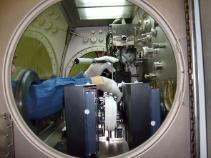
Floating at 250 miles above the planet, the International Space Station (ISS) provides a unique laboratory to conduct pioneering investigations.
By being permanently in orbit, it allows scientists to carry out experiments with the help of on-board astronauts and gain new insights into challenges we face on Earth.
This April, a machine designed at Strathclyde and built by UK-firm QinetiQ, was launched from Cape Kennedy in Florida into orbit on the station for the cutting edge ‘particle vibration’ experiment.
The station, a joint programme between USA, Russia, Japan, Europe (ESA) and Canada, is equipped with a host of modern research equipment.
The experiments needed three months of continuous activities, a period of microgravity that only the ISS can provide.
‘Microgravity’ removes the effect of gravity to see the effects of other forces that can be hard to reveal on Earth and enabled researchers to test the behaviour of solid particles dispersed in a liquid in a variety of operating conditions.
New materials
The trial showed that by heating and shaking complex fluids – liquids that contain fine solid particles or other liquid droplets – in space’s microgravity environment, new materials can be created.
The hope is it will create future new medicines and environmentally friendly metals, as well as generate theories to explain how planets, moons and asteroids are formed.
It follows a chance discovery by Project Leader, Professor Marcello Lappa from the Department of Aerospace and Mechanical Engineering,that the combined influence of vibrations and heat applied to a liquid containing particles can be used to force particles to self-organise and form very regular structures.
Professor Lappa said:
Space is not only a place to be explored. It is also a fantastic place or laboratory to develop new ideas, test new theories and implement new technical solutions.
“We discovered this phenomenon by conducting sophisticated numerical computer simulations. Now this principle has been successfully verified in a real microgravity environment and it will lead to future materials with better properties or completely new materials with properties that cannot be obtained on Earth.”
The method works by precisely controlling the position of particles dispersed in a fluid. Many materials, before being solid, pass through a liquid state that consists of particles or droplets dispersed in an external liquid or matrix - just like a cake with raisins inside.
Many metal alloys and protein crystals used for the production of medicines are also produced in the form of small particles inside a larger matrix. The properties of these materials in their final solid state depend on the position of these particles.
Incredible things
In the past control of particles dispersed in a fluid has been attempted using magnetic or electric fields. The new method doesn’t require the materials to be sensitive to these fields, which means it can also be used to produce organic materials.
Professor Lappa added: “We have demonstrated that by shaking a fluid-particle mixture in the absence of gravity, particles can do incredible things. Instead of being randomly displaced, surprisingly particles can be forced to cluster and form perfect networks and their position can be controlled very precisely.”
The new methods would mean manufacturing processes could produce materials directly in space, which could then used on Earth for advanced applications. This could include special metal alloys characterised by an internal framework or backbone able to address stresses or forces acting in specific directions, or non-metallic materials able to conduct electricity - materials essentially made of plastics but which can also conduct electricity, and protein crystals used in vaccine delivery.
Microgravity research
Professor Lappa added: “The next step will be making the method available to industry, pharmaceutical companies, academia and research centres. I am already working with the UK Space Agency and the UK Satellite Application Catapult on creating an academic and industrial network to take advantage of other research projects in microgravity.
The experiment enlisted the assistance of on board astronauts. But while Professor Lappa said that being able to personally visit the ISS is a ‘dream’ for most researchers, it would take years of training and an exceptional ability to bear adverse conditions.
He added: “I suffer from seasickness and probably I would not be in a condition to bear an environment where there is no gravity. It would be like swimming through a liquid. But during the experiment execution, I did enjoy monitoring all the activity remotely through a real-time connection.”
Science Minister George Freeman said the experiment paved the way for ‘“exciting scientific discoveries that could transform methods of manufacturing, demonstrating just how valuable a resource space can be for growth and industry in the UK and around the world.”
Particle Vibration is the third experiment funded directly by the UK Space Agency to fly to the ISS. The first, called Molecular Muscle 2, launched in June 2021 and saw scientists from Nottingham and Exeter University send thousands of tiny worms to live on board the space station for several days to help understand spaceflight-induced muscle decline.
The second, called MicroAge, launched in December 2021, with scientists from the University of Liverpool, sending tiny human muscle cells, the size of a grain of rice, into space to understand what happens to human muscles as we age, and why.
Libby Jackson, Head of Space Exploration at the UK Space Agency, said: “Particle Vibration shows how investing in space exploration, and the research in space that it enables, can benefit us here on Earth.
“In-space manufacturing harnesses the benefits of the space environment to create materials that are of much higher quality that those we can create on Earth, and that can be used to improve production of all sorts of materials crucial to our health and growth.”
Professor Sir Jim McDonald, Vice-Chancellor and Principal of the University of Strathclyde said: “At Strathclyde we are proud of our track record in space innovation and this is a great example of the cutting edge research happening across the University.”
